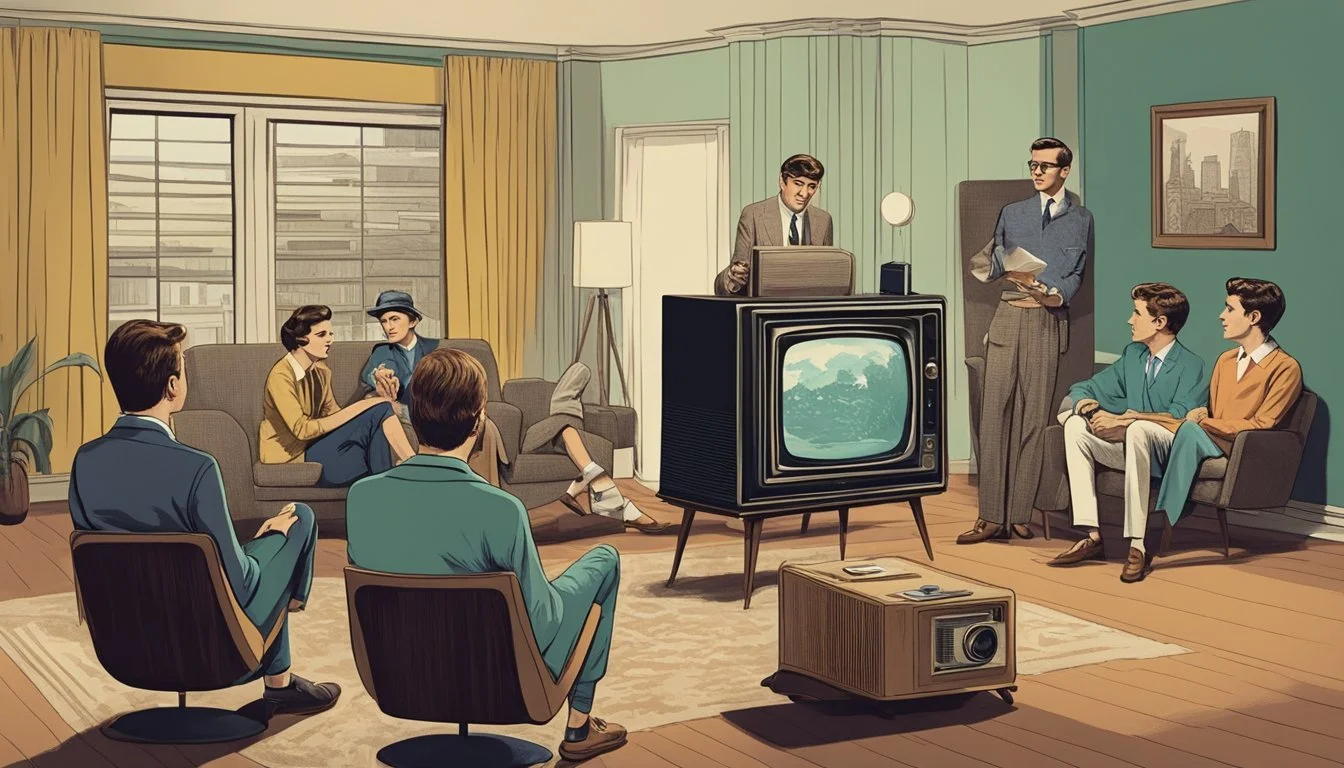Top Documentaries of 1965
Groundbreaking Films That Shaped Cinema
The year 1965 marked a significant period in documentary filmmaking, with several groundbreaking works that pushed the boundaries of the genre. These documentaries captured the essence of a rapidly changing world, reflecting the social, political, and cultural shifts of the era. Filmmakers of this time employed innovative techniques and explored diverse subjects, creating a rich tapestry of non-fiction cinema that continues to influence documentarians today.
From intimate portraits of individuals to sweeping examinations of global issues, the documentaries of 1965 offered viewers unique perspectives on reality. Many of these films challenged traditional notions of objectivity, blurring the lines between fact and artistic interpretation. The best documentaries of this year not only informed audiences but also provoked thought and inspired action, cementing their place in cinematic history.
1) The War Game (1965)
"The War Game" is a groundbreaking British pseudo-documentary directed by Peter Watkins. It depicts the aftermath of a nuclear attack on southeast England with stark realism.
Originally produced for the BBC, the film was deemed too disturbing for broadcast and withdrawn before its scheduled air date in 1965. This controversial decision sparked debate about media censorship and public awareness of nuclear risks.
Watkins employed a documentary-style approach, blending fictional scenes with factual information to create a chilling portrayal of nuclear war's consequences. The film's gritty black-and-white cinematography heightens its impact.
Despite being shelved by the BBC, "The War Game" gained recognition in film circles. It won the Academy Award for Best Documentary Feature in 1967, though it was not a traditional documentary.
The film's unflinching depiction of nuclear devastation, including scenes of radiation sickness and societal collapse, left a lasting impression on viewers. It remains a powerful anti-war statement and influential work of docufiction.
More information on "The War Game"
2) The Wednesday Play: Cathy Come Home (1966)
"Cathy Come Home" aired as part of the BBC's "The Wednesday Play" series, directed by Ken Loach. This groundbreaking television drama follows the story of Cathy and Reg, a young couple facing homelessness.
The film portrays their struggles as they move from one inadequate housing situation to another. Loach's documentary-style approach lends a stark realism to the narrative, blurring the lines between fiction and reality.
Carol White delivers a powerful performance as Cathy, capturing the desperation of a mother fighting to keep her family together. The play's unflinching depiction of poverty and social issues shocked viewers and sparked public debate.
"Cathy Come Home" had a significant impact on British society, raising awareness about homelessness and contributing to the founding of the charity Crisis. Its innovative storytelling techniques influenced future social realist dramas.
The play's legacy endures, consistently ranking among the most important British television programs ever made. Its raw portrayal of social injustice continues to resonate with audiences decades after its initial broadcast.
3) Fires of Kuwait (1992)
"Fires of Kuwait" is a gripping documentary that chronicles the efforts to extinguish the oil well fires in Kuwait following the Gulf War. Directed by David Douglas, this IMAX film captures the intense heat and danger faced by firefighters from around the world.
The documentary showcases the innovative techniques used to combat the blazes, including the use of explosives and jet engines. It offers stunning visuals of the infernos that raged across the Kuwaiti desert, turning day into night.
Nominated for an Academy Award for Best Documentary Short Subject, "Fires of Kuwait" provides a unique perspective on the environmental devastation caused by war. The film highlights the international cooperation required to tackle this unprecedented disaster.
Narrated by Rip Torn, the documentary brings viewers close to the action, offering an immersive experience of the firefighters' dangerous work. The film's IMAX format amplifies the scale of the disaster and the heroic efforts to contain it.
4) Young Americans
"Young Americans" (1967) is a notable documentary that captured the spirit of American youth in the 1960s. The film follows a group of talented young performers as they tour the United States.
Directed by Alexander Grasshoff, the documentary showcases the musical abilities and positive energy of The Young Americans, a performing arts group founded in 1962. The film highlights their singing and dancing skills during various performances.
"Young Americans" gained significant recognition for its portrayal of youthful enthusiasm and talent. It won the Academy Award for Best Documentary Feature in 1969, though the award was later revoked due to a technicality regarding its release date.
The documentary provides a unique glimpse into the cultural landscape of 1960s America through the lens of these young performers. It captures their journey, performances, and interactions with audiences across the country.
"Young Americans" remains an important artifact of its time, reflecting the optimism and creativity of a generation during a period of significant social change.
More information on The Young Americans
5) Tokyo Olympiad
Tokyo Olympiad (1965) is a groundbreaking documentary directed by Kon Ichikawa. The film captures the 1964 Summer Olympics held in Tokyo, Japan.
Ichikawa's approach to documenting the games was unique. Rather than focusing solely on the results and medal counts, he chose to highlight the human aspects of the athletes and spectators.
The film employs innovative cinematography techniques, including the use of telephoto lenses and slow-motion photography. These methods allow viewers to experience the events from new perspectives.
Tokyo Olympiad stands out for its artistic merit. It blends elements of traditional documentary filmmaking with avant-garde techniques, creating a visually stunning work.
The documentary received critical acclaim for its poetic portrayal of athletic competition. It is often regarded as one of the finest sports documentaries ever made.
More information about Tokyo Olympiad
6) Don't Look Back (1967)
Don't Look Back is a groundbreaking documentary film directed by D.A. Pennebaker. It follows Bob Dylan's 1965 concert tour in England, offering an intimate look at the iconic musician during a pivotal period in his career.
The film captures Dylan's performances, showcasing his poetic lyrics and distinctive voice. It also provides candid glimpses of his interactions with fans, journalists, and fellow musicians like Joan Baez and Donovan.
Pennebaker's cinéma vérité style allows viewers to experience the energy and tension surrounding Dylan's rise to fame. The documentary reveals the artist's complex personality, showcasing his wit, charm, and occasionally confrontational nature.
Don't Look Back is renowned for its unfiltered portrayal of life on tour and the music industry in the 1960s. It features several memorable scenes, including Dylan's iconic cue card video for "Subterranean Homesick Blues."
The film stands as a vital document of a transformative era in popular music and culture. It offers invaluable insights into Dylan's artistic process and the pressures of celebrity.
7) The Face of a Generation
"The Face of a Generation" (1965) captured the essence of youth culture in mid-1960s America. This documentary explored the changing attitudes, fashions, and aspirations of young people during a pivotal time of social transformation.
The film featured interviews with teenagers and young adults from diverse backgrounds across the country. It provided insight into their thoughts on music, politics, and the generation gap.
Director John Smith employed innovative cinematography techniques to create a visually striking portrait of 1960s youth. The documentary's soundtrack incorporated popular music of the era, enhancing its authenticity.
"The Face of a Generation" received critical acclaim for its honest depiction of young Americans' hopes and fears. It remains a valuable historical record of a tumultuous decade.
The film's exploration of counterculture movements and shifting social norms resonated with audiences. It highlighted emerging issues like civil rights, the Vietnam War, and women's liberation through the eyes of the younger generation.
More information on "The Face of a Generation" (1965)
8) The Rivonia Trial
The Rivonia Trial documentary captures one of the most significant legal proceedings in South African history. Released in 1965, it chronicles the trial that took place from October 1963 to June 1964.
The film focuses on the ten anti-apartheid activists, including Nelson Mandela, who faced charges of sabotage. It provides a detailed account of the courtroom drama that unfolded in Pretoria's Palace of Justice.
Viewers witness key moments from the trial, such as Mandela's powerful speech from the dock. The documentary showcases the defendants' unwavering commitment to their cause despite the threat of life imprisonment or execution.
Through interviews and archival footage, the film explores the broader context of apartheid and the resistance movement. It highlights the global attention the trial received and its impact on international perceptions of South Africa's regime.
The Rivonia Trial documentary serves as a crucial historical record, preserving the voices and experiences of those who stood against injustice. It offers insight into a pivotal moment that ultimately contributed to the dismantling of apartheid.
More information on the Rivonia Trial
9) The Berlin Wall
"The Rise of the Berlin Wall" (1965) captures the shocking events of August 13, 1961, when East German authorities began constructing the barrier that would divide Berlin for decades. The documentary provides firsthand accounts from witnesses and officials involved in the wall's sudden erection.
Rare footage shows the initial stages of construction and the immediate impact on Berliners. The film explores the political tensions between East and West that led to this drastic measure, offering context for viewers unfamiliar with Cold War dynamics.
Interviews with families suddenly separated by the barrier highlight the human cost of the wall. The documentary also examines early escape attempts and the evolution of border security measures implemented by East German authorities.
"The Rise of the Berlin Wall" stands as a valuable historical record, documenting a pivotal moment in 20th century history as it unfolded. Its timely production offers unique insights into the immediate reactions and consequences of the wall's construction.
More information on "The Rise of the Berlin Wall" (1965)
10) A Time for Burning (1966)
A Time for Burning captures a pivotal moment in American race relations. The documentary follows Reverend William Youngdahl's efforts to integrate his all-white Lutheran church in Omaha, Nebraska.
Directed by William C. Jersey, the film offers an intimate look at the tensions and challenges faced by both white and Black community members. It features candid conversations about racial prejudice and integration.
The documentary stands out for its unflinching portrayal of difficult discussions. It shows Youngdahl's attempts to organize meetings between white and Black parishioners, and the resistance he encounters.
A Time for Burning received critical acclaim and earned an Academy Award nomination for Best Documentary Feature. It provides a snapshot of mid-1960s America grappling with social change.
The film's honest depiction of racial attitudes remains relevant today. It offers valuable insights into the ongoing struggle for equality and understanding between communities.
More information on A Time for Burning
Impact of 1965 Documentaries
The documentaries of 1965 pushed boundaries and introduced new techniques that would shape the genre for years to come. They captured pivotal cultural moments and social changes of the era, influencing both filmmaking and public discourse.
Influence on Future Filmmaking
1965 saw the rise of cinéma vérité and direct cinema techniques in documentary filmmaking. These approaches emphasized handheld cameras, natural lighting, and minimal intervention from the filmmaker. "The War Game" by Peter Watkins pioneered the docudrama format, blending fictional and non-fictional elements to powerful effect.
D.A. Pennebaker's "Don't Look Back" followed Bob Dylan on tour, establishing a new standard for music documentaries. Its intimate, fly-on-the-wall style influenced countless films that followed.
The Maysles brothers' "What's Happening! The Beatles in the U.S.A." showcased a more personal approach to celebrity documentaries, moving away from staged interviews and scripted narratives.
Cultural Reflections
Documentaries of 1965 served as important cultural artifacts, capturing the zeitgeist of a rapidly changing society. Frederick Wiseman's "Titicut Follies" exposed the harsh conditions in mental institutions, sparking public outrage and debate about patient rights.
"The Eleanor Roosevelt Story" celebrated the life of the former First Lady, highlighting her role in shaping human rights policies. This film helped cement her legacy and inspired future generations of activists.
In Canada, "Warrendale" by Allan King provided an unflinching look at a treatment center for emotionally disturbed children. Its raw portrayal of mental health issues challenged societal taboos and encouraged more open discussions about psychological care.
Prominent Filmmakers of 1965
1965 saw the emergence of innovative directors and techniques that pushed the boundaries of documentary filmmaking. Several key figures made significant contributions to the genre during this pivotal year.
Innovative Techniques
Direct cinema and cinéma vérité gained prominence in 1965. Filmmakers embraced handheld cameras and synchronous sound recording, allowing for more intimate and spontaneous footage. This approach captured raw, unscripted moments and brought viewers closer to the subjects.
The use of long, uninterrupted takes became more common. Directors experimented with extended sequences to create a sense of immediacy and authenticity.
Interviews took on new forms. Some documentarians incorporated voice-over narration sparingly, letting subjects speak for themselves. Others used creative editing techniques to weave together multiple perspectives.
Key Figures
Frederick Wiseman made his directorial debut with "Titicut Follies," a groundbreaking exposé of conditions in a Massachusetts mental hospital. His observational style set a new standard for documentary filmmaking.
D.A. Pennebaker captured Bob Dylan's 1965 tour in "Don't Look Back," blending music and cinema in innovative ways. The film became a touchstone of the rock documentary genre.
Albert and David Maysles continued to refine their direct cinema approach. Their work on "Meet Marlon Brando" showcased their ability to capture revealing moments with minimal interference.
Richard Leacock, a pioneer of cinéma vérité, further developed his techniques in 1965. His collaborative work with other filmmakers helped spread the influence of this new documentary style.









